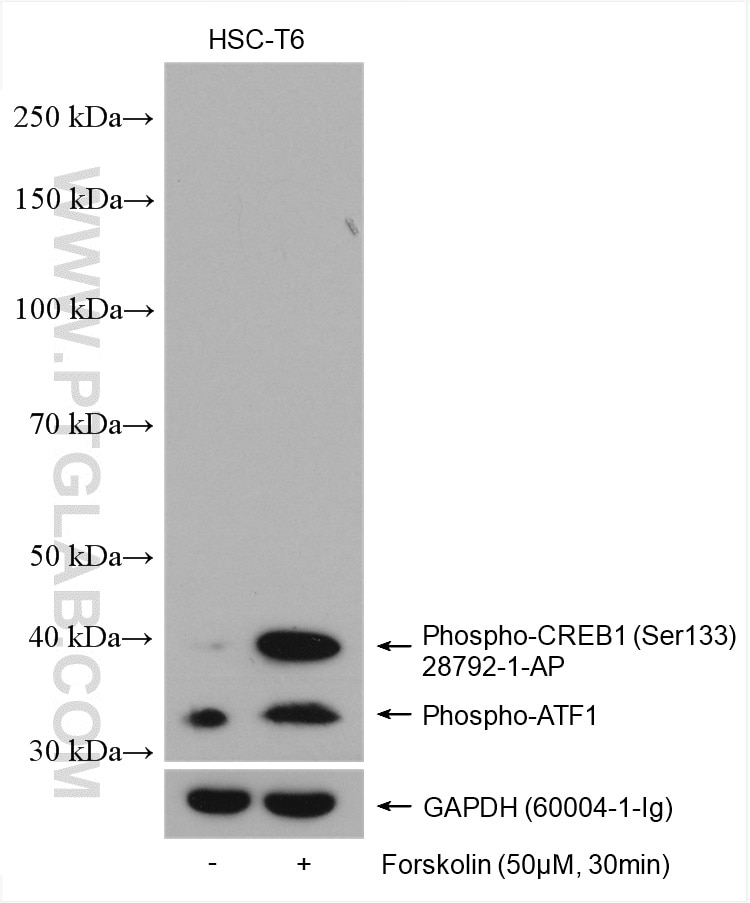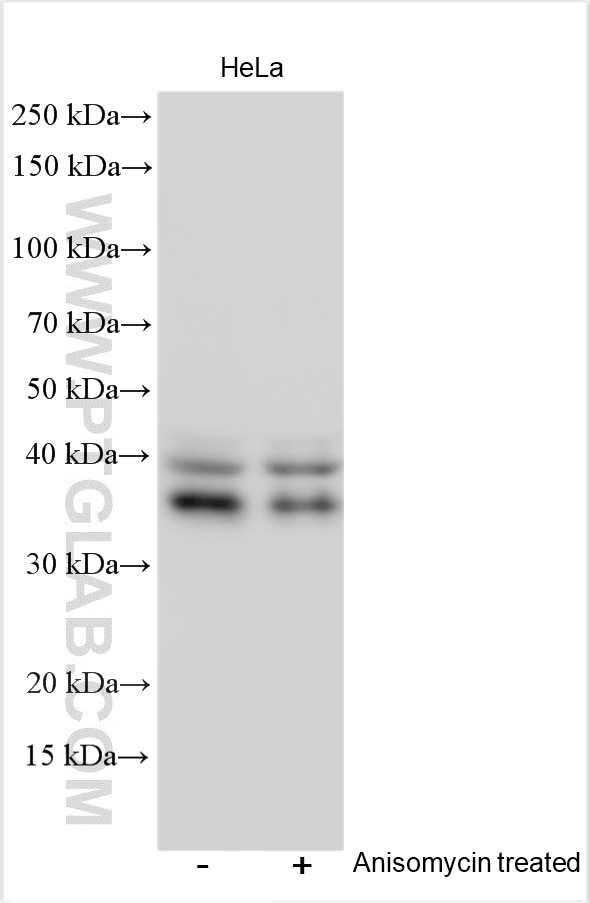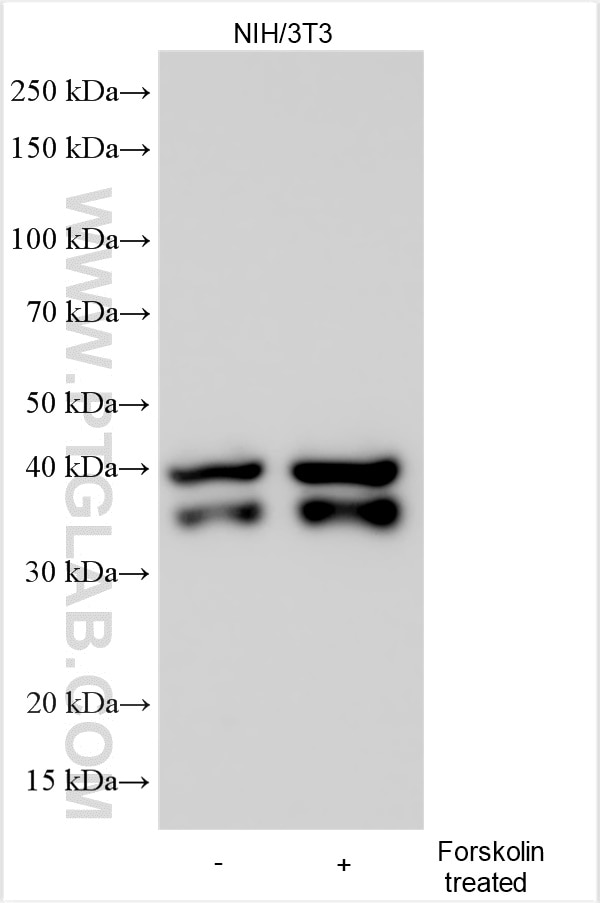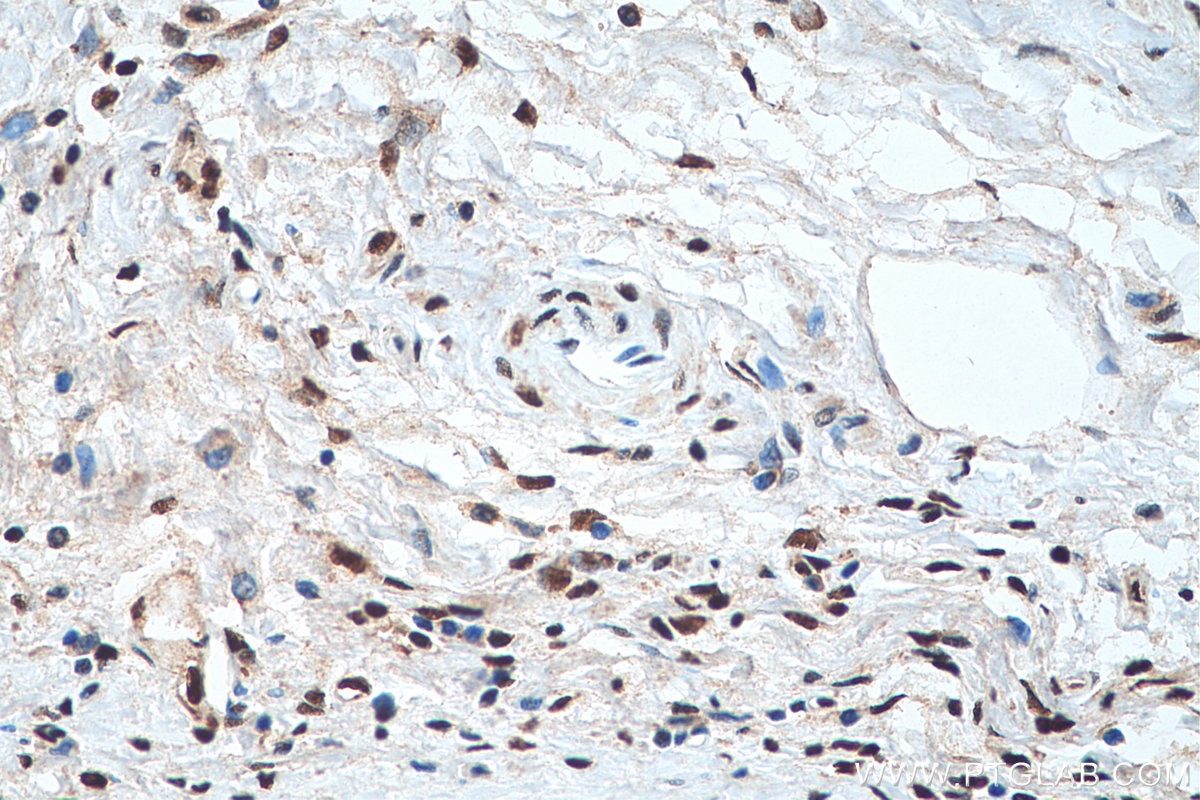Phospho-CREB1 (Ser133) Polyklonaler Antikörper
Phospho-CREB1 (Ser133) Polyklonal Antikörper für WB, IHC, ELISA
Wirt / Isotyp
Kaninchen / IgG
Getestete Reaktivität
human, Maus, Ratte
Anwendung
WB, IHC, IF, ELISA
Konjugation
Unkonjugiert
Kat-Nr. : 28792-1-AP
Synonyme
Geprüfte Anwendungen
| Erfolgreiche Detektion in WB | mit Forskolin behandelte HSC-T6-Zellen, HeLa-Zellen, NIH/3T3-Zellen |
| Erfolgreiche Detektion in IHC | humanes Lebergewebe Hinweis: Antigendemaskierung mit TE-Puffer pH 9,0 empfohlen. (*) Wahlweise kann die Antigendemaskierung auch mit Citratpuffer pH 6,0 erfolgen. |
Empfohlene Verdünnung
| Anwendung | Verdünnung |
|---|---|
| Western Blot (WB) | WB : 1:1000-1:8000 |
| Immunhistochemie (IHC) | IHC : 1:50-1:500 |
| It is recommended that this reagent should be titrated in each testing system to obtain optimal results. | |
| Sample-dependent, check data in validation data gallery | |
Veröffentlichte Anwendungen
| WB | See 42 publications below |
| IHC | See 1 publications below |
| IF | See 1 publications below |
Produktinformation
28792-1-AP bindet in WB, IHC, IF, ELISA Phospho-CREB1 (Ser133) und zeigt Reaktivität mit human, Maus, Ratten
| Getestete Reaktivität | human, Maus, Ratte |
| In Publikationen genannte Reaktivität | human, Maus, Ratte |
| Wirt / Isotyp | Kaninchen / IgG |
| Klonalität | Polyklonal |
| Typ | Antikörper |
| Immunogen | Peptid |
| Vollständiger Name | cAMP responsive element binding protein 1 |
| Berechnetes Molekulargewicht | 341 aa, 35 kDa |
| Beobachtetes Molekulargewicht | 35-46 kDa |
| GenBank-Zugangsnummer | BC010636 |
| Gene symbol | CREB1 |
| Gene ID (NCBI) | 1385 |
| Konjugation | Unkonjugiert |
| Form | Liquid |
| Reinigungsmethode | Antigen-Affinitätsreinigung |
| Lagerungspuffer | PBS with 0.02% sodium azide and 50% glycerol |
| Lagerungsbedingungen | Bei -20°C lagern. Nach dem Versand ein Jahr lang stabil Aliquotieren ist bei -20oC Lagerung nicht notwendig. 20ul Größen enthalten 0,1% BSA. |
Hintergrundinformationen
The cAMP-response element binding protein (CREB) is localized in the nucleus and acts as a transcription factor, which binds to the cAMP response element (CRE) of the promoters of its target genes, upon phosphorylation at Ser133 by different receptor-activated protein kinases, such as protein kinase A (PKA), calmodulin-dependent protein kinase (CaMK), mitogen-activated protein kinases (MAPK), and other kinases. The activity of CREB1 in neurons has been correlated with various intracellular processes, including proliferation, differentiation, survival, long-term synaptic potentiation, neurogenesis, and neuronal plasticity. CREB1 belongs to the CREB/activating transcription factor (ATF) family of transcription factors. (PMID: 30214393, PMID: 33917483, PMID: 32605164) The antibody also detects the phosphorylated form of the CREB-related protein ATF1.
Protokolle
| PRODUKTSPEZIFISCHE PROTOKOLLE | |
|---|---|
| WB protocol for Phospho-CREB1 (Ser133) antibody 28792-1-AP | Protokoll herunterladen |
| IHC protocol for Phospho-CREB1 (Ser133) antibody 28792-1-AP | Protokoll herunterladenl |
| STANDARD-PROTOKOLLE | |
|---|---|
| Klicken Sie hier, um unsere Standardprotokolle anzuzeigen |
Publikationen
| Species | Application | Title |
|---|---|---|
Free Radic Biol Med Reprimo (RPRM) mediates neuronal ferroptosis via CREB-Nrf2/SCD1 pathways in radiation-induced brain injury | ||
FASEB J Ketone body 3-hydroxybutyrate mitigates apoptosis and enhances osteogenesis in bone organoid construction via the cAMP/PKA/CREB signaling pathway | ||
J Ethnopharmacol Yangjing Zhongyu decoction facilitates mitochondrial activity, estrogenesis, and energy metabolism in H2O2-induced human granulosa cell line KGN. | ||
Brain Res Bull Metabotropic glutamate receptor 5 upregulation of γ-aminobutyric acid transporter 3 expression ameliorates cognitive impairment after traumatic brain injury in mice. | ||
Int J Biol Macromol Lactoferrin ameliorates cognitive impairment in D-galactose-induced aging mice by regulating the PI3K/Akt/mTOR signaling pathway and the microbiome-gut-brain axis | ||
Phytomedicine Peiyuan Ningshen-ointment alleviates learning and memory impairment induced by sleep deprivation through activating the cAMP/PKA signaling pathway |





